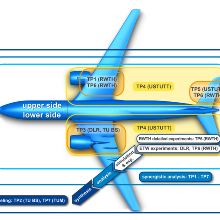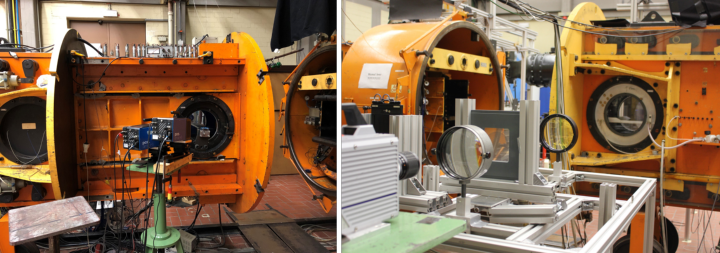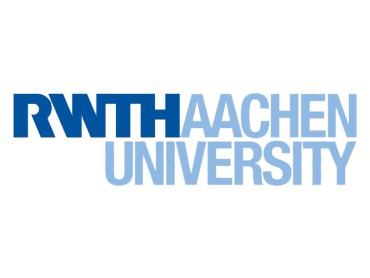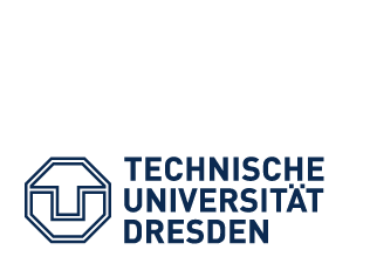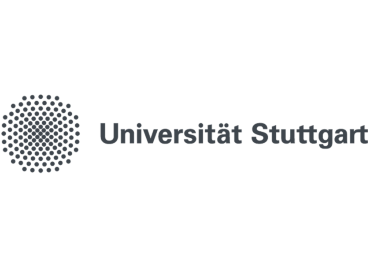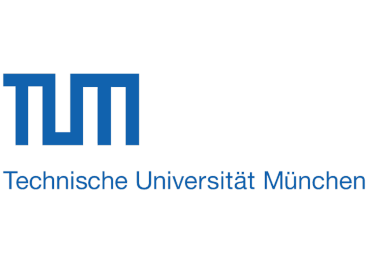TP1
Numerical Analysis of the Influence of Engine Disturbances on the Buffet Phenomenon
The transonic flow over wings is characterized by the occurrence of local supersonic flow regions which are terminated by a shock wave the strength of which increases with freestream Mach number and angle of attack. Above a sufficient strength, the shock wave induces flow separation which under certain flight conditions, due to the interaction between the detached flow and the shock wave, results in self-excited periodic shock oscillations, which are denoted buffet. The buffet phenomenon defines an extremely critical load state for the overall flight stability. With regard to the ever-increasing importance of virtual flight tests and the necessary optimization of the weight of the essential supporting structure, it is essential to exactly predict and to understand in detail the impact of perturbations in the flow field on the onset and existence of buffet. Due to the ecologically and economically driven development of modern, more efficient UHBR engines (Ultra-High Bypass Ratio) with increasing diameter and their pronounced vicinity to the wing, stronger unsteady intricate interactions between the engine jet and the flow over the wing occur which are significant for the aerodynamic integration of the engine. This relation, which has not been investigated in the literature, defines the motivation for this numerical subproject, to determine the influence of the perturbations generated by the engine on the onset of shock oscillations on the suction side of the wing and the modifications on the model to describe buffet. The following hypothesis is in the center of the investigations. The sound field generated at the trailing edge of the wing is impacted by the perturbations on the pressure side of the wing, which among other disturbances are due to the engine. Therefore, a different interaction between shock wave and sound pressure level results which leads to modified shock wave oscillations on the suction side.
TP2
Data Analysis and Flow Modeling
Buffet is a byproduct of shock-boundary layer interaction in the transonic regime. Coupled with three-dimensional geometry (swept wing, nacelle, pylon), the buffet phenomenon yields a complex non-linear flow which is challenging to analyze and to model. Analyzing the flow results, particularly the large-scale LES and DES simulations that are planned in this research unit, requires dedicated tools to handle the large data as well as to extract the relevant information. Large data create both a storage and an analysis problem. Existing approaches to reduce the data size typically rely on selective sampling and on filtering. In this project, the so-called Sparse Spatial Sampling (S3) method is to be extended and applied in order to reduce the large numerical grid sizes and to compress the simulation results. This in turn enables better data management and simplified evaluation of the results. Data analysis methods are numerous. They include proper orthogonal decomposition (POD) and dynamic mode decomposition (DMD), which are currently the two most powerful and popular tools in fluid dynamics. Both spectral methods shall be further developed and adapted in this project as part of the xROM toolbox, which shall be shared with the entire research group. In addition to the adaptation and sharing of the xROM, TP2 will closely work with the FOR partners to interpret the results. Modeling fluid flows provide physical insights as well as the ability to perform predictions. In this project two modelling strategies will be considered and extended: The dynamic mode decomposition (DMD) and the cluster-based reduced models (CROM). The DMD identifies and quantifies the relevant modes and their stability. Two DMD variants (multi-resolution DMD and randomized DMD) shall be combined to better identify the range of spatio-temporal modes and to enable calculations on very large datasets. The results of the DMD stability analysis shall be compared with those of the cooperation partner Dr. Sebastian Timme, who uses the global stability analysis. In addition, two cluster-based approaches shall be used for analysis and modelling: the Metric Attractor Overlap (MAO) and the Cluster-based Reduced Models (CROM). These data-driven methods are well suited to characterize and to quantify the differences between different flow conditions (or different types of simulations) and to model nonlinear flows.
TP3
Aerodynamic Interference of Wing Lower Side, Engine, and Pylon for High-Speed Off-Design Flow Conditions
The sub project is concerned with shock-boundary layer interactions and buffet phenomena on the lower side of wing, engine nacelle, and pylon. Depending on their relative positions, these components cause strong flow accelerations for commercial aircraft with under-the-wing mounted engines. Especially for UHBR engines, the related aerodynamic interference phenomena are not known. The research activities are characterized by a combination of maturation and verification of high fidelity methods for turbulence resolving simulations, code validation based on cryogenic wind tunnel experiments, and an increased aerodynamic understanding based on the usage of efficient methods for data reduction. This approach is complemented by steady and unsteady RANS-simulations with Reynolds stress modelling of statistical turbulence in order to explore fundamental aerodynamic properties of the XRF-1 configuration with UHBR engine in the non-linear lift regime. The enhancement of the hybrid RANS/LES method is focusing on a combination of the IDDES approach for local wall-modelled turbulence with a differential Reynolds stress modelling for the statistical turbulence as well as an adaptation of algebraic sensors for the required generation of synthetic turbulence. The thereby enhanced HRLM functionality is then verified on the XRF-1 configuration with the LES-simulation being limited for this purpose to a region at the inner wing/pylon junction. Building up on this study, a wall-function approach for the LES-simulation will be investigated and verified, offering the potential to reduce the required grid resolution. The detailed aerodynamic investigations are characterized by a spatial extension of the LES region in lateral and longitudinal direction, with the LES-studies of the wing/pylon junction serving as a starting point. In one approach, the region with resolved turbulence is extended upstream including also the nacelle to identify unsteady interferences between the supersonic flow fields on the nacelle with those in the wing/pylon junction. The other approach will extend the LES-region in lateral direction, as supersonic flow fields are expected to cover the whole lower wing between nacelle and pylon up to the fuselage. In order to assess the new simulation approach, reference solutions are generated for selected flow conditions using RANS and URANS simulations with an improved grid resolution and carefully adjusted unsteady numerical parameters. These studies will also cover unsteady variations of the on-flow conditions as well as a further increase in Reynolds number.
TP4
Physical Analysis of Interactions between Wing Wake and Tailplane at High-speed Stall Conditions
Transonic buffet on airplanes is a complex phenomenon occuring due to the interactions of shock motion and three-dimensional shock-induced flow separation. The physically correct reproduction of the turbulent wake's starting conditions, propagation and interaction with the tailplane is essential in order to perform accurate simulations of these flow phenomena by means of CFD. Furthermore, the integration of modern UHBR nacelles leads to an increase in complexity of the expected flow phenomena, which has not yet been sufficiently investigated. In order to gain a deeper understanding of these flow phenomena in the context of transport aircraft, the overall goal of this subproject of FOR2895 is to investigate the influence of shock-induced flow separation at the wing on the tailplane and the resulting flow effects and interactions. Predictions about the origin and development of the wake, as well as the potentially safety-critical loads imposed on the tail by the transient wake will be made to achieve this goal. The hybrid RANS/LES methodology used in this subproject will be validated by means of simulations on a tandem wing configuration that will be concurrently experimentally investigated in the trisonic wind tunnel of RWTH Aachen University (TP6). The comparison of these simulation results with the experimental data as well as with detailed LES simulations from TP1 and TP5 should allow a deeper physical understanding of the transonic flow phenomena at the front wing, the development of the wake and its interaction with the rear wing. Based on the findings of this study, hybrid RANS/LES simulations will be performed on the XRF-1 aircraft configuration with and without UHBR nacelle. The focus will be on predicting the flow field downstream of separation and on the analysis of the physical mechanisms occurring there and in the near wake. Additionally, the influence of a UHBR nacelle will be investigated in the wake close to the wing. The development of the scales and structures of the turbulent wake and the interaction of the wake with the tailplane will be analysed afterwards. Measurements carried out in the ETW cryogenic wind tunnel (ETW measurement project) on the wing, UHBR nacelle, wake and tailplane will be used for validation of the simulations. In addition, the results are to be compared with high-resolution LES simulations in the shock area (TP1) as well as in the area of the interaction between the wake and the tailplane (TP5). In the cases with engine nacelle, hybrid RANS/LES simulations from TP3 serve as additional specific validation of the simulation methodology.
TP5
Large Eddy Simulation of the Interaction of Wing Wake and Horizontal Tail Plane under Buffet Conditions
The interaction of wing wake and the horizontal tail plane (HTP) flow in transport aircraft is a little explored topic of research. In particular in the case of high-speed stall, when the main wing experiences strong flow separation and possible shock buffet, the resulting wake is highly unsteady and irregular. While the effects of stall and buffet on the aerodynamic and structural forces on the main wing have been investigated in great detail, almost no attention has been given to the situation at the HTP. The limited number of published investigations that exist indicate that the flow at the HTP can experience significant load fluctuations and separation due to the incoming wake. The main goal of this research proposal is therefore to conduct a scale-resolving simulation of this wake – boundary layer interaction in order to analyze the resulting flow physics, to improve understanding of this complex flow situation and to characterize the load fluctuations. The main hypothesis proposed here is that this non-linear interaction of two turbulent flows constitutes a complex multiscale problem, in which local, small scale features can influence the macroscopic scale. Thus, an accurate and reliable numerical representation of this interaction demands a scale-resolving numerical discretization in the sense of a Large Eddy Simulation, in which at least the outer parts of the boundary layer are resolved. In order to achieve this goal, a parallel, coordinated measurement and simulation campaign together with the other subprojects is designed. In a first step, a basic tandem configuration at lower Reynolds number is investigated experimentally at RWTH Aachen. These measurements will be accompanied by the simulations and serve to validate the LES results and extend the capabilities towards wall modeled approaches and thus higher Reynolds numbers. The results will be analyzed together with the associated subprojects. The flow physics results will be compared against the highly accurate measurement data and DES simulations. The spatio-temporal modes and spectra of the solution will be analyzed with regards to the buffet, the load fluctuations and the influence of the small scale effects on large scale quantities. Based on these findings, the wake-HTP interaction at the XRF-1 configuration at flight Reynolds numbers will be investigated and again analyzed together with the associated subprojects. Overall, this research proposal thus contributes to the understanding of the complex interaction of a highly unsteady, turbulent wake and the boundary layer at the HTP and associated loads and flow physics and provides a well-validated prediction method for future developments.
TP6
Turbulent Structures and Dynamic Mechanisms in Transonic Airfoil Buffet and in the Onteraction between Airfoil Wake and Tailplane
Close to the boundaries of the flight envelope, the transonic flow around modern transport aircraft is characterized by strong unsteady aerodynamic effects. On the suction side of transonic airfoils, areas of supersonic flow with subsequent normal shock waves occur. The shock strength increases with angle of attack and flow Mach number and can cause massive flow separation on the airfoil. The interaction between the shock and the boundary layer on the airfoil can furthermore induce periodic self-sustaining shock oscillations (buffet), which strongly affect the aerodynamic loads and can induce potentially detrimental structural oscillations (buffeting). These phenomena reduce the life span of the airfoil and limit the flight envelope regarding angle of attack and Mach number. In addition to these direct influences on the airfoil aerodynamics, unsteady dynamic effects are also imprinted on the flow around the tailplane via the wake of the airfoil. This leads to very complex flow configurations that have not yet been investigated and understood in detail. Therefore, the understanding and predictability of buffet mechanisms on swept wings is necessary to expand the boundaries of the flight envelope while maintaining high aviation safety standards. For this, a deeper understanding of the underlying mechanisms of 2D buffet is a prerequisite. The overall goal of this project (TP6) is the fundamental identification and understanding of the interrelations between the phenomena and mechanisms of transonic airfoil buffet and the flow around the tailplane. To achieve this, high-resolution experimental data will be generated and used to carry out detailed investigations of the relevant phenomena in synergy with the numerical data generated within the Research Unit. Previously, the buffet phenomenon has been investigated at Reynolds numbers significantly below the flight regime. To close this gap, the project contributes to the planned measurement campaigns in the European Transonic Windtunnel (ETW). In addition, fundamental experimental investigations on an unswept tandem-wing configuration are carried out at a Reynolds number that is accessible for current high-fidelity numerical methods. The project can therefore analyze the flow physics, effects of high Reynolds number and airfoil sweep, and support the further development of numerical methods. Stereo-Dual-Particle Image Velocimetry measurements provide velocity-field data that also contain acceleration information for these complex flows. Combined with advanced post-processing methods for the analysis of coherent turbulent structures (Proper Orthogonal Decomposition und Dynamic Mode Decomposition) and spectral analysis, this unique data set will allow insights that will significantly advance the understanding of transonic airfoil buffet and its influence on the tailplane aerodynamics at Reynolds numbers realistic for the flight regime at the boundary of the flight envelope.
TP7
Neuro-Fuzzy-based Reduced-Order Modeling for Aerodynamic Loads Computation at High-Speed Buffet Conditions
The accurate aerodynamic loads determination at the limits of the aircraft’s flight envelope is essential for reducing uncertainties within the design process and to yield optimized structures with respect to mass and stiffness distributions. The overall goal of this subproject within the research group FOR 2895 is, therefore, to develop a class of neuro-fuzzy-based reduced-order models that can be used for efficient load computation and analysis at transonic buffet conditions. These models will be thoroughly investigated concerning their accuracy, robustness and sensitivity against variations of Mach number, angle of attack and Reynolds number. Therefore, the results of the reduced-order model will be evaluated in comparison to experimental and numerical reference data. Particular challenges arise for the training process of the reduced-order model, which must be adapted to the dominating flow physics in order to be able to reproduce the dynamic characteristics and maximum values of the unsteady aerodynamic airloads with sufficient accuracy. In order to improve the prediction quality, both experimental and numerical results will be used to train the neuro-fuzzy model. Hence, the transient load characteristics of a realistic transport aircraft configuration under high-speed stall conditions can be recorded. The present subproject focuses on neuro-fuzzy-based methodologies, which are considered promising for the modeling of unsteady aerodynamic loads due to stochastic shock motion and predominant nonlinear interactions.
ETW measurement project
Within the framework of the research group, in five sub-projects (TP1, TP3-TP5, TP7), complementary numerical investigations are carried out on the high-speed stall of transport aircraft configurations, which are evaluated synergistically with wind tunnel experiments from TP6 and with the tools developed in TP2 and interpreted in terms of flow physics. The flow effects to be investigated in the research group's sub-projects show a strong dependency on the Reynolds number, which makes the use of a corresponding experimental database with correct Reynolds and Mach numbers essential to achieve the scientific goals. Such measurement data does not exist in the required level of detail, so that measurements in the ETW cryogenic wind tunnel are necessary and will constitute a data set that is unique in the world.
The measurement data mentioned are collected in the "ETW Messprojekt" coordinated by the DLR. The latest non-contact measurement techniques, such as time-resolved flow field measurements using PIV (TR-PIV) or transient pressure measurements using pressure-sensitive paint (iPSP), are used for these measurements. In the ETW campaigns, for the first time, unsteady force, pressure distribution, flow field and deformation measurements are carried out on a transport aircraft configuration under real flight conditions up to the borders of the flight envelope. An ETW campaign is planned for each year over the entire duration of the research group. The definition of the measurement programs is based on the scientific requirements of the research group. Since measurements in cryogenic wind tunnels and the provision of correspondingly instrumented, cryogenic-compatible wind tunnel models are very cost-intensive, the ETW measurement project is financed with the help of significant support from the HGF and the DLR.
To carry out scientifically based ETW measurements, Airbus designed the wind tunnel model of a modern transport aircraft configuration (XRF-1). Airbus makes this wind tunnel model available to DLR for expansion and measurement in the ETW. In order to pick up on current development trends for the use of UHBR engines and to be able to study the strong interferences that occur with the wing and its wake with regard to buffet effects, the conventional engine nacelles are replaced by new UHBR nacelles. The UHBR components are designed, manufactured and instrumented in the ETW measurement project for the XRF-1 wind tunnel model.


